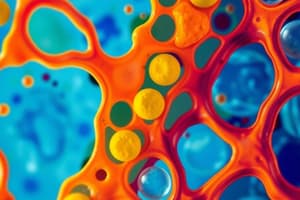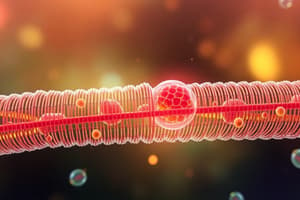Podcast
Questions and Answers
What characterizes the structure of the cell membrane?
What characterizes the structure of the cell membrane?
- A phospholipid bilayer with embedded proteins (correct)
- A single-layer membrane with lipid anchors
- An inner layer of carbohydrates and cholesterol
- A rigid outer shell made of proteins
What function does selective permeability of the cell membrane serve?
What function does selective permeability of the cell membrane serve?
- It creates a rigid barrier against extracellular fluids.
- It regulates the movement of substances in and out of the cell. (correct)
- It prevents any cellular communication.
- It allows all substances to enter the cell freely.
Which type of transport requires energy input from the cell?
Which type of transport requires energy input from the cell?
- Active transport (correct)
- Diffusion
- Osmosis
- Facilitated diffusion
What role do carbohydrates play on the cell membrane?
What role do carbohydrates play on the cell membrane?
In the fluid mosaic model, what is the nature of the cell membrane?
In the fluid mosaic model, what is the nature of the cell membrane?
What is the primary function of cholesterol in the cell membrane?
What is the primary function of cholesterol in the cell membrane?
Which transport mechanism involves engulfing materials into the cell?
Which transport mechanism involves engulfing materials into the cell?
What is the main importance of the cell membrane in cellular function?
What is the main importance of the cell membrane in cellular function?
Flashcards are hidden until you start studying
Study Notes
Structure of the Cell Membrane
- Composed of a phospholipid bilayer.
- Contains embedded proteins, cholesterol, and carbohydrates.
- Proteins can be integral (spanning the membrane) or peripheral (attached to the surface).
Functions of the Cell Membrane
- Barrier: Separates the internal environment of the cell from the external environment.
- Selective Permeability: Regulates the movement of substances in and out of the cell.
- Cell Communication: Contains receptors for signaling molecules.
- Cell Recognition: Carbohydrates on the surface serve as recognition sites for other cells.
Composition of the Cell Membrane
- Phospholipids: Hydrophilic (water-attracting) heads and hydrophobic (water-repelling) tails.
- Proteins: Facilitate transport, act as enzymes, or serve as receptors.
- Cholesterol: Maintains membrane fluidity and stability.
- Carbohydrates: Attached to proteins (glycoproteins) or lipids (glycolipids); important for cell recognition.
Membrane Transport Mechanisms
- Passive Transport: Movement of molecules without energy input.
- Example: Diffusion, osmosis, facilitated diffusion.
- Active Transport: Movement against concentration gradient, requiring energy (ATP).
- Example: Sodium-potassium pump.
- Endocytosis: Process of engulfing materials into the cell.
- Types: Phagocytosis (solid) and pinocytosis (liquid).
- Exocytosis: Process of expelling materials from the cell.
Fluid Mosaic Model
- Describes the cell membrane as a dynamic and fluid structure with various proteins floating in or on the phospholipid bilayer.
- Illustrates flexibility and the ability for components to move laterally within the layer.
Importance of the Cell Membrane
- Essential for maintaining homeostasis.
- Critical for communication and signaling within and between cells.
- Plays a role in cell interaction and immune response.
Structure of the Cell Membrane
- Made of a phospholipid bilayer that forms the basic structure.
- Embedded proteins, cholesterol, and carbohydrates contribute to functionality.
- Integral proteins span the membrane, while peripheral proteins attach to its surface.
Functions of the Cell Membrane
- Serves as a barrier, isolating the cell's internal environment from the outside.
- Features selective permeability, controlling substance movement in and out of the cell.
- Contains receptors that facilitate cell communication through signaling molecules.
- Carbohydrates on the membrane surface enable cell recognition and interaction.
Composition of the Cell Membrane
- Phospholipids possess hydrophilic heads that attract water and hydrophobic tails that repel it.
- Membrane proteins assist in transporting substances, act as enzymes, or function as receptors.
- Cholesterol enhances the fluidity and stability of the membrane.
- Carbohydrates, in the form of glycoproteins or glycolipids, are vital for cellular recognition processes.
Membrane Transport Mechanisms
- Passive transport occurs without energy input, using methods such as diffusion and osmosis.
- Active transport requires energy (ATP) to move substances against their concentration gradient, exemplified by the sodium-potassium pump.
- Endocytosis involves engulfing materials into the cell, categorized into phagocytosis (for solids) and pinocytosis (for liquids).
- Exocytosis expels materials out of the cell.
Fluid Mosaic Model
- Describes the cell membrane as a dynamic structure where proteins float within or on the phospholipid bilayer.
- Demonstrates the flexibility of the membrane, allowing lateral movement of its components.
Importance of the Cell Membrane
- Crucial for maintaining homeostasis within the cell.
- Facilitates communication and signaling between individual cells.
- Plays a significant role in cell interactions and the immune response.
Studying That Suits You
Use AI to generate personalized quizzes and flashcards to suit your learning preferences.




